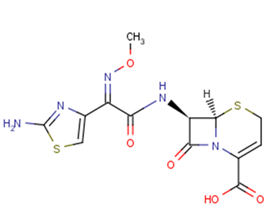
Ceftizoxime
CAS No. 68401-81-0
Ceftizoxime( —— )
Catalog No. M18995 CAS No. 68401-81-0
Ceftizoxime is a cephalosporin-based, potent antibacterial agent which can be administered intravenously or by suppository.
Purity : >98% (HPLC)
 COA
COA
 Datasheet
Datasheet
 HNMR
HNMR
 HPLC
HPLC
 MSDS
MSDS
 Handing Instructions
Handing Instructions
| Size | Price / USD | Stock | Quantity |
| 25MG | 36 | In Stock |


|
| 50MG | 43 | In Stock |


|
| 100MG | 71 | In Stock |


|
| 200MG | Get Quote | In Stock |


|
| 500MG | Get Quote | In Stock |


|
| 1G | Get Quote | In Stock |


|
Biological Information
-
Product NameCeftizoxime
-
NoteResearch use only, not for human use.
-
Brief DescriptionCeftizoxime is a cephalosporin-based, potent antibacterial agent which can be administered intravenously or by suppository.
-
DescriptionCeftizoxime is a cephalosporin-based, potent antibacterial agent which can be administered intravenously or by suppository. It is highly resistant to a broad spectrum of beta-lactamases and is active against a wide range of both aerobic and anaerobic gram-positive and gram-negative organisms.(In Vitro):Ceftizoxime is a new parenteral cephalosporin derivative which is more active against various gram-negative bacilli, including the opportunistic pathogens such as Enterobacter, Citrobacter species, and Serratia marcescens, than cephalosporins and cephamycins such as cefotiam, cefamandole, cefuroxime, cefotaxime, and cefmetazole. Ceftizoxime shows a broad spectrum of antibacterial activity against aerobic gram-positive and gram-negative bacteria.(In Vivo):The therapeutic effect of Ceftizoxime in mice infected with a small inoculum size is almost the same as that of cefotaxime. Ceftizoxime is stable in biological fluids such as serum, urine, and tissue homogenates, but cefotaxime is unstable in rat tissue homogenates. Binding of ceftizoxime to serum protein in all species is the lowest of all the antibiotics: 31% for humans, 17% for dogs, and 32% for rats.
-
In VitroCeftizoxime is a new parenteral cephalosporin derivative which is more active against various gram-negative bacilli, including the opportunistic pathogens such as Enterobacter, Citrobacter species, and Serratia marcescens, than cephalosporins and cephamycins such as cefotiam, cefamandole, cefuroxime, cefotaxime, and cefmetazole. Ceftizoxime shows a broad spectrum of antibacterial activity against aerobic gram-positive and gram-negative bacteria.
-
In VivoThe therapeutic effect of Ceftizoxime in mice infected with a small inoculum size is almost the same as that of cefotaxime. Ceftizoxime is stable in biological fluids such as serum, urine, and tissue homogenates, but cefotaxime is unstable in rat tissue homogenates. Binding of ceftizoxime to serum protein in all species is the lowest of all the antibiotics: 31% for humans, 17% for dogs, and 32% for rats.
-
Synonyms——
-
PathwayOthers
-
TargetOther Targets
-
RecptorAntibacterial
-
Research AreaInfection
-
Indication——
Chemical Information
-
CAS Number68401-81-0
-
Formula Weight383.41
-
Molecular FormulaC13H13N5O5S2
-
Purity>98% (HPLC)
-
SolubilityDMSO : 25 mg/mL 65.21 mM
-
SMILESCO\N=C(/C(=O)N[C@H]1[C@H]2SCC=C(N2C1=O)C(O)=O)c1csc(N)n1
-
Chemical Name——
Shipping & Storage Information
-
Storage(-20℃)
-
ShippingWith Ice Pack
-
Stability≥ 2 years
Reference



-
2-Methylsuccinic aci...
Methylsuccinic acid is a normal metabolite found in human fluids. Increased urinary levels of Methylsuccinic acid (together with ethylmalonic acid) are the main biochemical measurable features in ethylmalonic encephalopathy a rare metabolic disorder with an autosomal recessive mode of inheritance that is clinically characterized by neuromotor delay hyperlactic acidemia recurrent petechiae orthostatic acrocyanosis and chronic diarrhea.
-
TXNIP-IN-1
TXNIP-IN-1 is an inhibitor of the TXNIP-TRX complex and used in the research of TXNIP-TRX complex associated metabolic disorder (diabetes), cardiovascular disease, or inflammatory disease.
-
Riociguat
Riociguat is a stimulator of guanylate cyclase which causes relaxation of vascular smooth muscle and is used to treat severe pulmonary arterial hypertension.



 Cart
Cart
 sales@molnova.com
sales@molnova.com


